Acer AL2216W: a worthwhile compromise?
by Jarred Walton on March 10, 2007 3:00 PM EST- Posted in
- Displays
Calibrated Results
Brightness and Contrast Ratio
While a lot of people may never use a properly calibrated monitor, image professionals definitely need accurate colors. Here, we report scores for the same areas as we did on the previous page, only this time the results are taken after we have used Monaco Optix XR to calibrate the display.
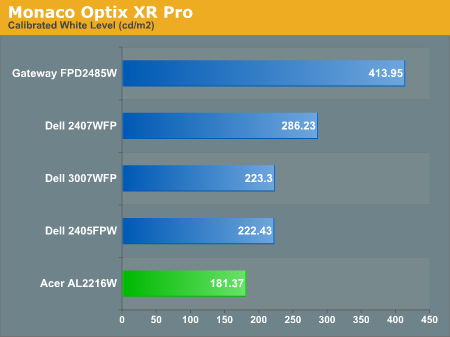
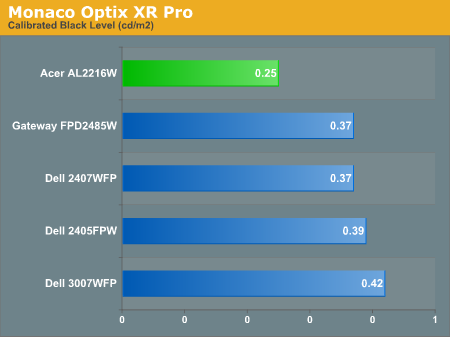
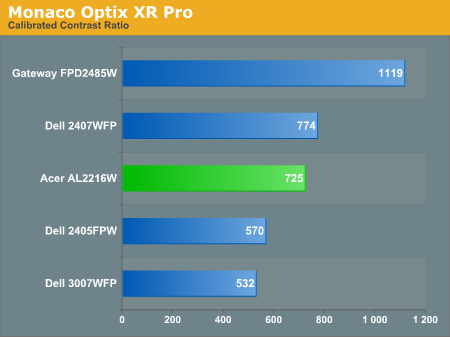
The most significant changes from calibration come in the area of brightness, where all of the displays end up running at less than their maximum brightness. You can of course choose to run a display of a higher than recommended brightness level, and the ambient lighting in a room will also determine what brightness setting is best. Our testing was performed indoors with a moderate amount of lighting, and the displays were adjusted accordingly.
Color Accuracy
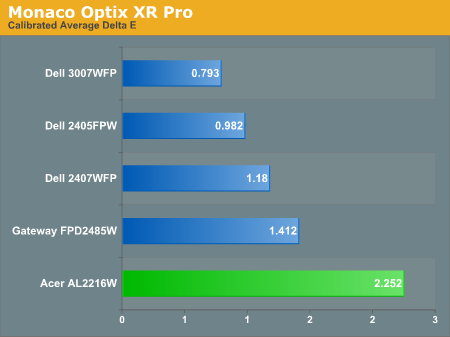
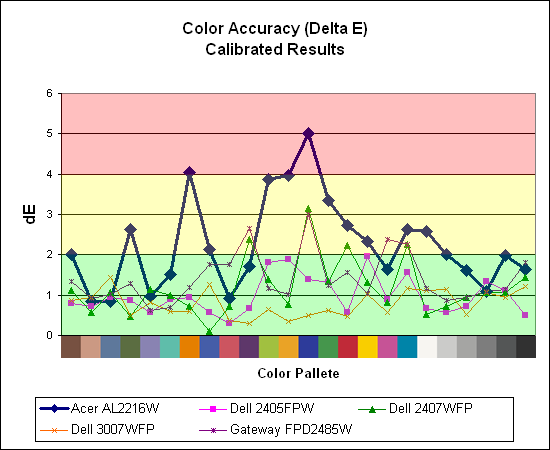
After placing at the top of the uncalibrated results for color accuracy, it's interesting that the Acer AL2216W comes in last after calibrating the monitor. The scores are still acceptable to the vast majority of people, but basically it is almost impossible to get "perfect" colors from the AL2216W. Whether that is due to the TN panel type or merely a result of cost cutting measures, image professionals will almost certainly want to look elsewhere.
Brightness and Contrast Ratio
While a lot of people may never use a properly calibrated monitor, image professionals definitely need accurate colors. Here, we report scores for the same areas as we did on the previous page, only this time the results are taken after we have used Monaco Optix XR to calibrate the display.



The most significant changes from calibration come in the area of brightness, where all of the displays end up running at less than their maximum brightness. You can of course choose to run a display of a higher than recommended brightness level, and the ambient lighting in a room will also determine what brightness setting is best. Our testing was performed indoors with a moderate amount of lighting, and the displays were adjusted accordingly.
Color Accuracy


After placing at the top of the uncalibrated results for color accuracy, it's interesting that the Acer AL2216W comes in last after calibrating the monitor. The scores are still acceptable to the vast majority of people, but basically it is almost impossible to get "perfect" colors from the AL2216W. Whether that is due to the TN panel type or merely a result of cost cutting measures, image professionals will almost certainly want to look elsewhere.










32 Comments
View All Comments
anandtech02148 - Sunday, March 11, 2007 - link
That viewing angle thing makes me proud of my 2yr old investment on the dell 2405fpw.Jarred when are they gonna give you a Dell 27inc 2707wfp to play?
27inc seems to be the right viewing angle for my future upgrade when price drop to 700usd or so.
BigDDesign - Saturday, March 10, 2007 - link
Great LCD reviews. Could you test some of the monitors that cater to graphic pros or photo pros like the Lacie 321 or NEC monitors. I currently am using a Lacie Electron Blue 22" and a Viewsonic 2050 LCDTV 20" for my workstation area. Every day I pray that my CRT will last forever. I know that someday that I'm going to have to replace my CRT with a LCD. Perfect color is top priority for some of us, over response times. With digital photography so mainstream, good color is very important to many. Perfect color is what I need.kmmatney - Saturday, March 10, 2007 - link
NewEgg has a new interesting monitor for sale, which I believe is an IPS panel, for $350. The link is here. Would be nice to review a monitor in the same price range which ay perform a lot better (with a slightly smaller screen and 4:3 aspect ratio).http://www.newegg.com/Product/Product.asp?Item=N82...">http://www.newegg.com/Product/Product.asp?Item=N82...
Bana - Saturday, March 10, 2007 - link
I'm glad to see that you tested the input lag (buffering) of the monitors this time around. I am unfortunate enough to be able to see and feel the difference on my mom's 2405fwp (hence why I haven't bought an LCD for myself). It would have been nice to see the monitors compared to a better baseline ie: a CRT monitor to get a more repeatable measurement. It'd also be nice to see get an actual response lag range like http://www.behardware.com/articles/647-4/which-22-...">BeHardware does.Thanks again Anandtech. :)
Chadder007 - Saturday, March 10, 2007 - link
On the color gradients....I don't understand how its supposed to look. It is supposed to look smooth throughout the colors going from dark to lighter? Or is it supposed to have a blocked look to the colors in sections?...or is that what is called banding?JarredWalton - Sunday, March 11, 2007 - link
It should be smooth, so the blocks are indeed banding. Without calibration, the banding tends to be a lot worse on some of the displays (particularly the Gateway FPD2485W).Den - Saturday, March 10, 2007 - link
What is interesting to me is that if you are not willing to spend an extra $200 on a color calibration device, the cheap Acer has FAR better colors than any of the more expensive panels that have been reviewed here so far. Indeed, since 99% plus of people don't have a calibration device, I think this should be weighed far more heavily than the calibrated values. (Obviously, professionals who do have a device will reverse this weighting, but for the rest of us...) Also, could AnandTech make their calibrated color profiles available for the rest of us to download? I realize there is some panel to panel variation so it would not be perfect for every owner of the same display, but for most I think it would be far better than the factory default.JarredWalton - Saturday, March 10, 2007 - link
I agree that the uncalibrated results are important, but at the same time I think most people will be okay with even Delta E of 6.0 if they don't know any better. Your eyes and brain are generally happy with what they see, whether or not it's 100% accurate. I've used a Dell 2405FPW for a long time without proper calibration and it never bothered me; now that I have a colorimeter, I suppose I'm seeing more "true" colors, but if I were to just walk up to a display and try to judge it it would be hard to say how it performs. For image professionals, a colorimeter should be standard equipment; for everyone else... unless the display is *really* bad, other aspects probably carry at least as much weight. The viewing angles, for example, normally don't bother us much, but the Acer panel clearly has a much narrower viewing arc.And since you asked, here's a link to the <a href="http://images.anandtech.com/reviews/monitor/2007/a...">http://images.anandtech.com/reviews/mon...ndtechCo... profiles</a> for all of the monitors, including both the print and standard profiles. The settings used for calibration are listed in the file names. Obviously, these are targeted at the panels we have, but as a baseline others may find them somewhat helpful. Cheers.
JarredWalton - Saturday, March 10, 2007 - link
Let me try that link again. :)http://images.anandtech.com/reviews/monitor/2007/a...">Downloadable Color Profiles
anandtech02148 - Wednesday, April 4, 2007 - link
This is very helpful Jarred, these files save us some time if we plan to invest in these monitors, it's already obnoxious to spend 600buxs on a monitor and another 1-2hr calibrating, such little details is mind boggling, and manufacture reset is not that great. Maybe they should hire a professional calibrator like yourself.